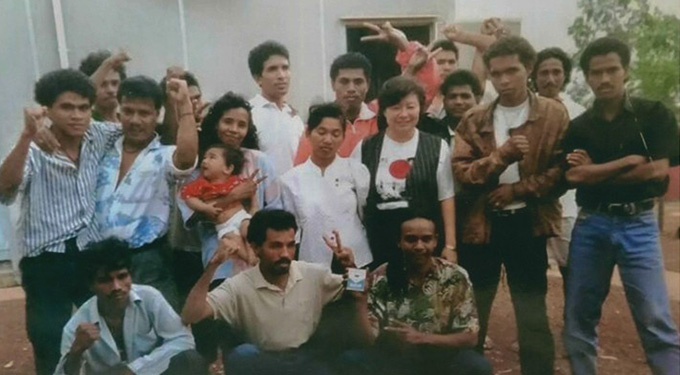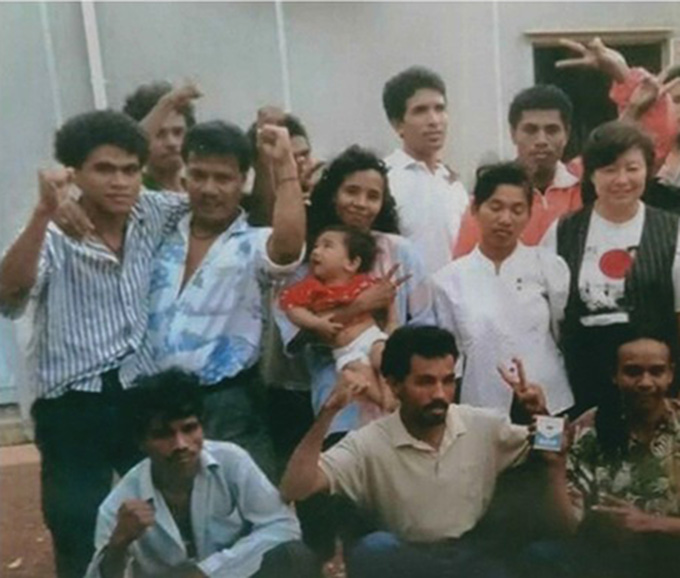By Vannessa Hearman and Jose da Costa
In 1995, 18 East Timorese youths sailed illegally to Australia in a small fishing boat. After five nights at sea they reached Australian waters. They were picked up by Australian Customs and brought to Darwin.
As young members of the clandestine movement opposed to Indonesian rule, many of the youths risked being captured, tortured or even killed in East Timor. Their voyage created a diplomatic nightmare for both countries.
Jose da Costa was 18 when he embarked on the journey. “Sometimes people asked me, why did you want to risk your life traveling on a small fishing boat to cross the ocean? The answer is, we didn’t want to but we had no choice.”
Da Costa was born six months after Indonesia’s December 1975 invasion. “I was born in the jungle near Uaimori, Viqueque district. My family had fled from Baucau to seek sanctuary after the invasion.”
After about two years, Indonesian encirclement and aerial bombardment made living conditions almost impossible for the fugitives. “Five of my siblings died from starvation. My uncle and his family were killed during the heavy bombardment by the Indonesian armed forces.”
The Indonesian military captured Da Costa’s family and transported them back to their village in Baucau, where their freedom of movement was curtailed.
When he was just eight years old, his father Bie Ono was lynched by the Indonesian military as he had been helping the anti-Indonesian forces. They made out Bie Ono had committed suicide and the villagers were brought to see his lifeless body.
Clandestine movement
In his teenage years, Da Costa joined the clandestine movement. He was badly tortured after participating in a protest march to the Santa Cruz cemetery in the capital, Dili, on 12 November 1991.
The march preceded a funeral procession for a Timorese activist who had been murdered by Indonesian troops. The Indonesian military opened fire on the protesters, killing 271 of them, in what became known as the Dili Massacre.
Young people who survived were rounded up and interrogated. Some never made it back out of the detention centres they were taken to.
Da Costa was one who did make it out of detention. Following his release, he began working as a courier, passing on goods and messages between the towns and the Timorese guerrillas in the mountains.
The boat voyage to Australia took some planning. Several young people had thought about travelling to Australia and seeking asylum, including other members of the clandestine network, such as Florentino Das Neves and Alfredo Reinado.
Reinado had lived and worked in Indonesia. As a young boy, he was forced to be a military assistant, carrying equipment and weaponry for the military. He joined the clandestine movement upon his return from Indonesia.
Da Costa, Das Neves and Reinado experimented with sailing a boat from Dili, but the canoe they bought only made it as far as Laga, 142 kilometres away.
On 12 November 1994, a group of Timorese youth jumped the fences of the United States Embassy in Jakarta and received asylum in Portugal. This renewed the Dili youths’ interest in the boat voyage. In consultation with Timorese pro-independence leaders, they resumed planning to sail to Australia, this time with a boat called Tasi Diak [Good Sea].
Father Domingos Maubere is a Catholic priest who played an active role in supporting the independence movement. As the 15 men, two women and one baby assembled on the beach at Tibar, 18 km west of Dili, to prepare for their departure, Father Domingos married Reinado to Maria Alves and baptised the couple’s six month-old baby, Billy Ray.
He then handed each person a small crucifix to hang around their neck “as a symbol of suffering and hope”.
Father Domingos told them, “My children, if I have not heard any news about you in seven days, I will bring candles and flowers to the sea to remember you as heroes of your country.”
His words suddenly brought the poignant realisation that they might not make it to Australia.

Hid behind mangroves
Da Costa recounted, “Father Domingos hid behind the mangroves and watched us sail away. From the boat, we saw his car lights slowly disappear behind the hill. We were then all alone. Just us and the sea.”
The journey took five nights and six days. Overloaded, the boat soon leaked and the passengers had to bail out water continuously. Luckily the sea remained placid until the second day of the voyage. Da Costa who, like most of the other passengers, was unable to swim recalled:
The waves were very rough, it was dark. We could not see anything we could only hear the sound of the waves hitting the boat and people vomiting. The only light that we had was a battery-powered torch to light the compass so we could see where to go. We could hear the sea water coming in and in the dark we were struggling to bail out the water. We were vomiting on each other, because we could not see in the dark. All night we struggled with the rough waves and tried to save the boat from sinking and there were no life jackets.
Tracking southeast, they didn’t tell the boat’s skipper Julio that Australia was their destination until the second day of the journey. They were confined to eating raw noodles and Indonesian military tinned rations, as a storm made it impossible to cook the sack of rice they brought. Eventually the storm cleared.
In the morning I was at the back of the boat pumping out the sea water. I saw a big group of dolphins jumping around and I remembered my father telling me that if you were at sea and you saw a dolphin you were very safe.
Da Costa recalled their arrival in Australian waters on the morning of 29 May 1995:
An Australian Customs boat sailed alongside our boat and we cut the boat’s engine, thinking they would bring us onto their boat. Instead two Customs officers jumped into our boat and restarted the engine. They asked us in English if we were Indonesian. Alfredo replied in his limited English, that we were Timorese. They put a light reflector on our boat and we followed them. When it was close to Darwin the officer tied a rope to our boat and towed us to Larakeyah naval centre. We arrived there around 2am Australian time [on 30 May 1995].
From the Naval Centre, they were brought to Darwin Airport, where they were to be accommodated. The following day, the group was rushed to the isolated Curtin RAAF Base in Western Australia, which had just been converted into a detention centre. This was partly to prevent the group, dubbed the Quail Group, from becoming a public rallying point for Timorese independence supporters in Darwin.
The Timorese community in Darwin had been alerted to the departure of the group from Dili and had been waiting anxiously for the boat’s arrival. Embarrassingly for the Indonesian government, the group’s arrival coincided with Indonesian Research and Technology Minister Baharuddin Jusuf Habibie’s visit to Australia. The Australian press quizzed him on the “boat people”.
Members of the “Quail group” were the only asylum seekers to arrive by boat from Indonesian-occupied East Timor. When they were released from Curtin detention centre, all 18 were issued bridging visas, allowing them to stay in Australia while their refugee claims were being assessed. They went to live with Timorese families in Melbourne, Sydney and Darwin.
Torture survivors
Da Costa, who like the other members of the group had been interviewed by the department of immigration, lawyers and counsellors, including those who specialised in working with torture survivors, said, “My group did not understand the visa process and we did not understand what the bridging visa meant. We only understood that we could not leave the country nor work or study in Australia.”
Foreign Minister Ali Alatas was livid at the issuing of the bridging visas. He argued that they were not genuine refugees, ridiculing their claims of torture. Despite then Foreign Minister Gareth Evans defending the issuing of the bridging visas, other Australian public officials bent over backwards to appease the Indonesian government.
Australian Ambassador to Indonesia Allan Taylor assured them that a bridging visa did not mean the East Timorese had been granted refugee status. Then Prime Minister Paul Keating put forward contradictory positions when he told The Guardian newspaper in October 1995: “Though the government has taken the view that East Timor . . . is a province of Indonesia, those people still have Portuguese citizenship and status.”
Australia was the only country to provide de jure recognition of Indonesian rule over East Timor (1975–99). But in this instance, Keating seemed prepared to junk that policy, at least momentarily for the sake of claiming that “these people have dual citizenship; therefore they cannot argue they are refugees”.
A second boat voyage was attempted when 35 people sailed from Dili in November 1995, but their boat was stranded on the coast due to bad weather and the passengers were arrested by Indonesian police.
In August 1999, the East Timorese people voted in a United Nations supervised referendum to reject Indonesian rule. Indonesian forces withdrew the following month, but only after destroying some 70 per cent of the territory’s buildings.
After Da Costa’s arrival, Australian governments, both Labor and Liberal, tried to repatriate over 1500 Timorese asylum seekers on the grounds that they had Portuguese citizenship and, after Indonesian rule ended, that East Timor was safe. After successive bridging visas, Da Costa received a special humanitarian visa (rather than refugee status) under Liberal Immigration Minister Amanda Vanstone in 2003, eight years after his arrival in Australia.
Vannessa Hearman is lecturer in Indonesian Studies at the University of Sydney. Jose Da Costa is a teacher, filmmaker and actor. He is completing a Master in Educational Studies at the University of New South Wales.This article was first published in Inside Indonesia and is republished here with permission.











































